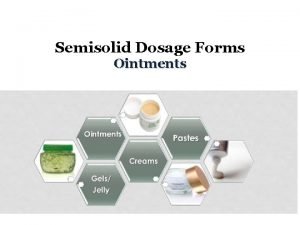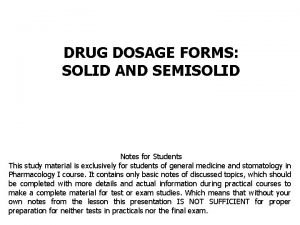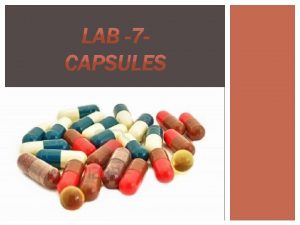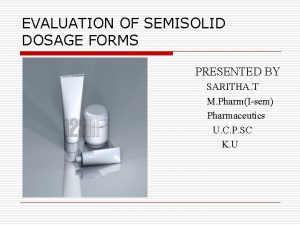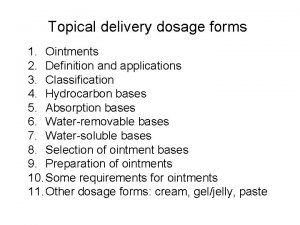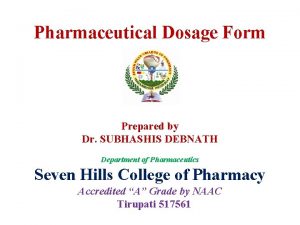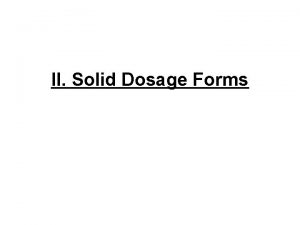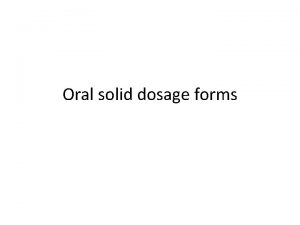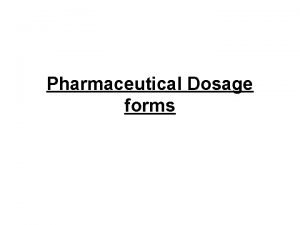Suppositories part 1 Suppositories Are solid dosage form











- Slides: 11

Suppositories part 1

Suppositories • Are solid dosage form intended for insertion into vaginal or rectal cavities where they melt, soften or dissolve and exert localized or systemic effects. • The shape and size of Suppositories must be such that it is capable of being easily insert into the intended body orifice without causing undue distention, and once inserted, it must be retained for appropriate period.

Types of suppository base AThe fatty bases: These bases melt at body temperature and consist of the naturally occurring theobroma oil (Cocoa – butter) and synthetic hard fats. BWater – soluble and water – miscible bases: These bases dissolve or disperse in the body fluids. There are two groups of water – soluble bases: 1. Glycero – gelatin bases. 2. Macrogol (PEG) bases.

Preparation of Suppository Suppositories are formulated in different shapes and sizes (usually 1 – 4 g). The suppository consists of a vehicle in which the drug is incorporated and in some cases, additives are co formulated. Suppositories are manufactured by two general methods: AFusion method (hot process): The drug is added to the melted base and the mixture allowed cooling after pouring into molds. BCompression method (cold process): The drug is incorporated with the un-melted base and the resulting mass shaped either by hand or by compression force in a metallic mold.

Manufacturing Suppositories

Mold calibration • The mold is generally made of melt in two halves which are clamped together with a screw. • The capacity of the mold is confirmed by filling the mold with the chosen base. The weight of the perfect products is taken and a mean weight calculated. This value is the calibration value of the mold for that particular base.


Displacement value (DVs) • The volume of a suppository from a particular mold is uniform but its weight will vary because the density of the medicaments usually differs from the density of the base. • The displacement value of a drug is the number of parts by weight of drug which displaces one part weight of the base

To calculate the DV of a drug: A batch of unmedicated suppositories is prepared and the products weighed. A batch of unmedicated suppositories containing a known concentration of the required drug is prepared and the products are weighted. Wight of six unmedicated suppositories = 6 g Wight of six unmedicated suppositories containing 40 % drug =8. 8 g Wight of base in this = 60 % = (600 / 100) ☓ 8 = 5. 28 g Weight of drug in suppositories = 40 % = (40 / 100) ☓ 8. 8 = 3. 52 g Weight of base displaced by drug = 6 – 5. 28 = 0. 72 g If the 0. 72 g of drug is displaced by 3. 52 of base, then 1 g of base will be displaced by 3. 52 / 0. 72 = 4. 88 g Therefore, displacement value of drug = 4. 9

Rx Bismuth subgallate 300 Cocoa butter q. s Ft. supp. Mitt. 6 supp. Using 1 g mold Calculations: To allow for unavoidable wastage calculate for eight suppositories. DV of bismuth subgallate = 2. 7 bismuth subgallate = 8 ☓ 300 mg = 2. 4 g /2. 7 = 0. 89 g displaced base The weight of base required to prepare eight unmedicated suppositories 8 ☓ 1 g = 8 g Therefore, weight of base required for medicated suppositories 8 – 0. 89 =7. 21

Thank You
 Mikael ferm
Mikael ferm Meaning of dosage form
Meaning of dosage form A homogeneous adhesive semi solid preparation
A homogeneous adhesive semi solid preparation Capsule solid dosage form
Capsule solid dosage form Pessaries dosage form
Pessaries dosage form Solid
Solid Advantages of semi solid dosage form
Advantages of semi solid dosage form Suppository solid dosage form
Suppository solid dosage form Ideal properties of semisolid dosage form
Ideal properties of semisolid dosage form What is absorption base
What is absorption base Advantages of solid dosage form
Advantages of solid dosage form Monophasic liquid dosage form
Monophasic liquid dosage form

